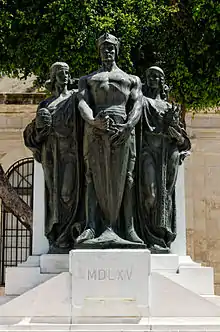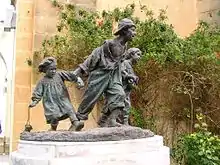Antonio Sciortino
Antonio Sciortino (Ħaż-Żebbuġ, 25 January 1879 – 10 August 1947) was a Maltese sculptor whose work reflects several artistic movements, including Realism and Futurism, as well as the influence of Auguste Rodin. He studied and worked in Rome. He developed an original style which drew the admiration of many and brought him commissions in Russia, Brazil and the United States. Sciortino was a director of the British Academy of Arts in Rome[1] (1911–1936), and from 1937 until his death he was a curator in the Malta Museum of Fine Arts.
Biography, work and style


From childhood Antonio Sciortino showed a tendency towards sculpture,[2] and his aunt Vittorine Sciortino encouraged him to follow this tendency. Encouragement also came from Lazzaro Pisani who was an established painter in Malta. It was this encouragement which caused Sciortino to enroll in the School of Art in Valletta where he studied for two years. The Strickland family helped Sciortino to obtain a government grant attend a course in Rome, at 22 he went to continue his studies in art.
In Rome, he studied in the Istituto Reale di Belle Arti[2] where for two years he studied engineering and monumental architecture. After earning a diploma with distinction, he opened an art studio in via Margutta 33 in the heart of the Roman artistic tradition. Here Sciortino decided to free himself from imitative tradition and develop a personal style. The Philosopher (1902) is a work of artistic study with which Sciortino established a reputation as an original artist and which drew the attention of many art critics. This sculpture, along with another known as Testa di Vecchio were shown in an exhibition with the name Promotrice di Roma.
With the statue Studio di Donna (1904) Sciortino withdrew from the prevailing habit of representing the female figure in the way inspired by the Greeks. In the same year Sciortino worked on Les Gavroches, a work which continued to improve his reputation. Depicting three poor children, the bronze statue is inspired by the Victor Hugo novel Les Miserables, in which Hugo describes the life of three poor street urchins living in the streets of Paris in the time of the French Revolution of 1848. This statue was brought to Malta in 1907 and is considered to be Sciortino's first masterpiece. The mould of the statue is today found in Buckingham Palace, a gift which the Government of Malta gave to Princess Elisabeth in the name of the Maltese people when she visited the islands in 1951.
In 1922, Sciortino examined the Isleworth Mona Lisa, and wrote a letter expressing his opinion that it "is a very beautiful picture and is in perfect state of preservation and in my opinion is school of Leonardo da Vinci, also 'Bottega di Leonardo' (Studio of Leonardo)".[3]
Asked how to say his name, he told The Literary Digest it was shore-TEA-no. (Charles Earle Funk, What's the Name, Please?, Funk & Wagnalls, 1936.)
Chronology
- 1902 Il filosfo – ?
- 1903 Testa di Vecchio – ?
- 1904 Studio di Donna – ?
- 1904 Les Gavroches – MUŻA, Valletta, Malta
- XXXX Twaqqif tas-sussidju mil-Gvern ta' Malta
- XXXX Jingħata Kummisjonijiet barra min Ruma
- 1907 Monument with bronze bust of Sir Adrian Dingli
- XXXX Lavoratore – Casa del Popolo Ruma
- 1909 – irredentismo
- XXXX Germinando un Idea
- XXXX Remorse
- XXXX Leo Tectomices
- XXXX Sciortino meets Auguste Rodin
- 1911 Design and model of Alessandru II
- 1913 Kompetizzjoni Statwa ta' Shevchenko
- 1913 Kristu Re
- 1914 bidu ta' xogħol fuq munument ta l-ewwel gwerra
- 1923 Pavlovic Cechov monument
- 1923/24 Rhythmii Vitae (Check Date)
- 1929 Siortino jieħu sehem f'kompetizzjoni internazzjonali f'Parigi
- 1931 talba ta' tħejjija ta' ghoxrin skultura ta' l-arti mill-Kummisjoni Ammerikana ta' l-arti
- 1936 The British Academy in Rome closes
- 1945 Monument of Lord Gerald Strickland
- 1947 Donates his work for the enjoyment of the public
Notes
- See Munro, Ion S. (11 December 1953). "The British Academy of Arts in Rome". Journal of the Royal Society of Arts. 102 (4914): 42–56. JSTOR 41368263.
- Antonio Sciortino’s Speed is going up for auction.
- John R. Eyre, The Two Mona Lisas: Which was Giacondo's Picture? (J.M. Ouseley and Son, Ltd., 1923), p. 36.
- ^ This article is largely based on Claude Busuttil 1997 – most of the facts have been compared and summarized.
- ^ Among other works, he also accomplished the mural paintings in St Paul's church in Valletta.
- ^ I'd be particularly interested in finding out what was the idea behind Sciortino's irredentismo. There is a paper on that, which I cannot get: E. Cozzani, 'I piu Giovani', in 'vita d'arte', II, vol. III, fs. 17, 1909 p. 257.
References
- Busuttil, Claude. (1997). Antonio Sciortino, 1879 – 1947, Europrint, 1997.
- Cremona, G. Artisti Maltesi a Roma, in Malta, 25 ta' Settembru, 1936.
External links
- https://web.archive.org/web/20080621143002/http://www.haz-zebbug.com/antonio_sciortino.php
- Sciortino at www.aboutmalta.com
- Three photographs (very low quality) of Sciortinos works. http://www.doi.gov.mt/EN/photo_gallery/artssciortino.asp